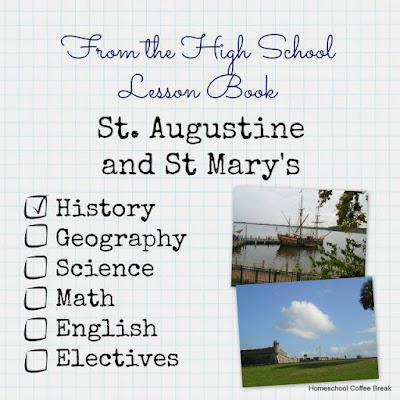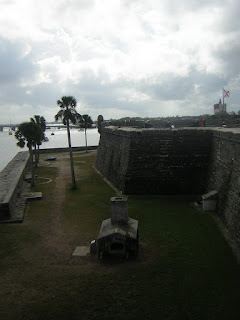This post may contain affiliate links - using affiliate links from Homeschool Coffee Break helps fuel this blog and our homeschool - thank you!
My apologies for the missing photos. I am in the process of updating the photos after changes to Photobucket's policies stopped 3rd party hosting.
My apologies for the missing photos. I am in the process of updating the photos after changes to Photobucket's policies stopped 3rd party hosting.
Landon is studying American history this year, using Exploring America from Notgrass. The first few units discuss some of the earliest European settlement in North America. Plimouth Plantation is probably the best known, but two other very early settlements were also important, and it just happens that we have visited them, so learning about those feels just a bit closer to home.
St. Augustine in Florida - This early Spanish settlement was mentioned in the text, but not in much detail. Since we've visited St Augustine, we've learned more about it in the past. St Augustine was established by Spain in 1565, the first permanent European settlement in what would later become the United States. The French and Spanish had been tussling over this area with the Timuca tribe for a few years, with the French trying to establish a settlement for Huguenots escaping religious persecution, and Spanish interested in expanding their shipping of gold and silver from the Americas. Inevitably, there were hostilities between the two European groups, with the Spanish coming out on top and establishing their center of power in North America. St. Augustine endured attacks, fires, and hurricanes over the years. England received it in treaty in 1763, then it was returned to Spain in 1784, before finally becoming part of the United States of America in 1821.
The Castillo de San Marcos was built by the Spanish to defend St Augustine, and is the oldest stone fort still standing in the US, with the city gates and a portion of the stone wall dating from 1702 still standing. Following are some of the pictures from our family's 2008 visit.
| The walls of the Castillo de San Marcos are made of coquina - a limestone formed by the shells of the coquina clam just off the coast. It's a solid but soft stone. The mortar is made from ground up shells as well. The walls are 12-19 feet thick, because the builders didn't know how coquina would stand up to cannonball fire. They DID know that the fort would not burn or be eaten by termites like wooden forts! It turns out the coquina not only stood up to cannon fire, but actually absorbed the shock and the cannonballs either bounced off a couple inches or stuck partway into the wall. The fact that the Spanish experimented with coquina as a building material probably changed history. Read more in the teacher's materials at the National Park Service website for Castillo de San Marcos: HERE. |

We also visited the Colonial Spanish Quarter Museum that offers a glimpse of how Spanish colonists lived during that time. One of the characters we met was a scribe-churchman, who explained to us that our family's British last name would likely have cost us our freedom, and perhaps our lives if we'd visited St Augustine during its Spanish heyday. Religious tolerance was not their strong point.

St Mary's City in Maryland - the British colony of Maryland, earned much better grades when it came to religious tolerance! The Protestant King of England granted the charter in 1632 to Sir George Calvert, the first Lord Baltimore, to found a colony north of Virginia. Calvert was a Catholic and hoped to create a safe place for other English Catholics who felt persecuted by the Anglicans. His sons established the settlement after his death, and the new colony of Maryland - named for the Catholic Queen Mary - guaranteed religious freedom for all Christian faiths. The policy was that there would be no official established religion, and this religious tolerance and freedom made the settlement unique in that time period. In fact, Protestants and Catholics alike were encouraged to settle in Maryland. As it happened, the majority of colonists were Protestant, but most of the wealthier families were Catholic.
St Mary's City was the fourth permanent British settlement in North America, founded in 1634. Today there is a living history museum at Historic St Mary's City where visitors can see colony life in action, including a working print house, an apothecary, a tobacco plantation, and the state house. There's also a replica of the ship that carried the first settlers to Maryland's shore.
| The replica Maryland Dove, a working square-rigged ship. |

We've made several visits to St Mary's City, but our first was when our family (minus Kennady, because she was just a little tyke) did an encampment with other homeschool families at Camp Flintlock. I would say it still ranks as our Most Memorable Field Trip Ever.
My previous posts:
History Lesson: St Mary's City
What's in your high school lesson book? Leave a comment and let me know!
What's in your high school lesson book? Leave a comment and let me know!
Don't miss a coffee break! Subscribe to Homeschool Coffee Break by Email!
©2006-2015 Homeschool Coffee Break. All rights reserved. All text, photographs, artwork, and other content may not be reproduced or transmitted in any form without the written consent of the author. http://kympossibleblog.blogspot.com/
We are a participant in the Amazon Services LLC Associates Program, an affiliate advertising program designed to provide a means for us to earn fees by linking to Amazon.com and affiliated sites.

















































5 comments:
Great photos and field trips!
Oooh. I remember going to Augustine when I was very very very little. I would love to go back...but it hasn't worked out! Thanks for sharing!
We're using the younger Notgrass American history this year. :-) It's great to live so near a site where you can go and actually experience history!
We've been to St. Augustine and Castillo de San Marcos. We'll have to make a trip over when we study American History next school year (we're doing World History this year).
I love this idea of posting weekly about high school activities. Maybe I'll have to try that in regards to my current high schooler. :)
interesting post. sounds like a great field trip.
Annette @ A net in time
Post a Comment
I love comments! It's like visiting over a virtual cup of coffee.